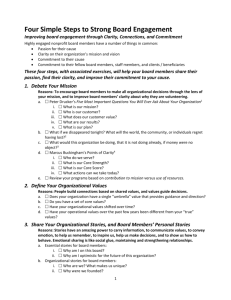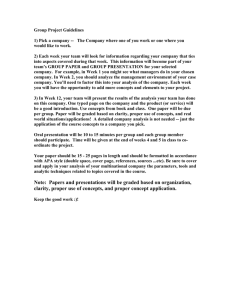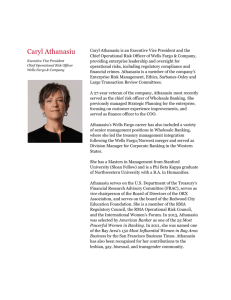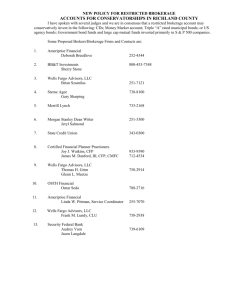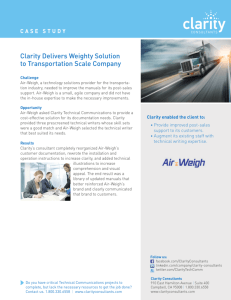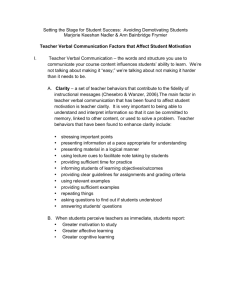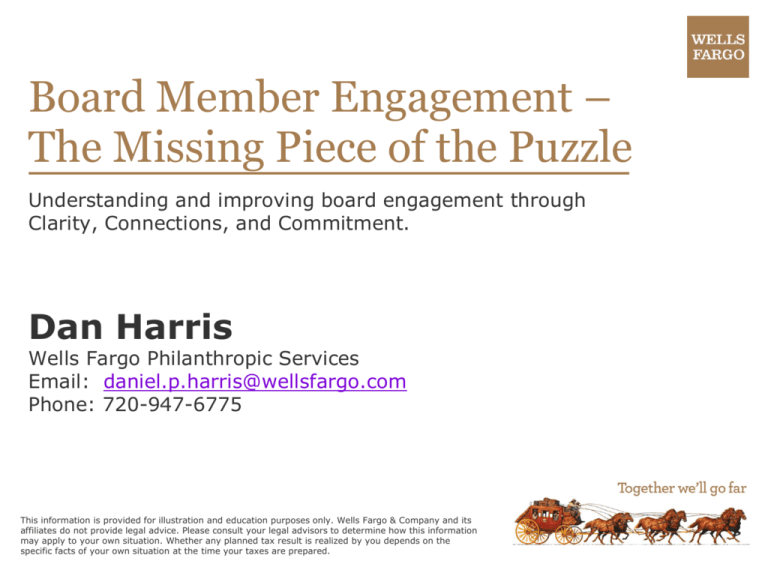
Board Member Engagement –
The Missing Piece of the Puzzle
Understanding and improving board engagement through
Clarity, Connections, and Commitment.
Dan Harris
Wells Fargo Philanthropic Services
Email: daniel.p.harris@wellsfargo.com
Phone: 720-947-6775
This information is provided for illustration and education purposes only. Wells Fargo & Company and its
affiliates do not provide legal advice. Please consult your legal advisors to determine how this information
may apply to your own situation. Whether any planned tax result is realized by you depends on the
specific facts of your own situation at the time your taxes are prepared.
Board Members’ Vital Role
“If an institution is having trouble raising money,
don’t look to the development office; don’t look to
the chief executive; first check out the board of
Trustees.”
- Fisher Howe, The Board Member’s Guide to Fundraising, 1991
“Board leadership and participation are essential
to successful fundraising. Raising money is also a
great deal of work and a true partnership between
board members and key staff.”
- G. Worth George, Fearless Fundraising for Nonprofit Boards, 2003
2
Characters You Might Meet on a Board
Avoidus Riski
Allis Welli
Divertus Attenti
Heidi Agenda
Spaci Cadetus
Lookus Smarti
Bendi Windi
Pompus Meani
Buy In, Saving Your Good Idea from Getting Shot Down, by John P. Kotter and Lorne A. Whitehead.
3
Defining Strong Engagement?
Engaged Directors…
4
Defining Strong Engagement?
Engaged Directors…
1. Are eager to participate
2. Rarely miss meetings, show up prepared, are respectful
3. Take ownership
4. Are reliable & responsible
5. Know everyone’s name
6. Volunteer beyond the board
7. Happily share their time and talent
8. Contribute at a “significant” level
9. Drink the Kool-Aid
10. Share the Kool-Aid
11. Actively champion our cause
by telling everyone about us
by making introductions
by participating with fundraisers…
5
The Board Member Experience
Orientation
Champion!
Positive
Retention path
ENGAGEMENT:
Happiness /
Confidence/
Satisfaction /
Optimism
Time
Departure path
Prospect
Negative
DOES NOT
Become
Board Member
Recruiting
Phase
Honeymoon!
Get the Work Done!
Phase
6
Relationship Building Takes Time
How to measure the connection
Level 1:
Awareness
Level 2:
Uniqueness
Level 3:
Acceptance
Level 4:
Level 5:
Affiliation
Champion
7
Benefits for the Board of Strong
Engagement?
8
Benefits for the Board of Strong
Engagement?
1.
2.
3.
4.
5.
6.
Efficiency
Improved governance
Help more clients
More friendly environment
Raise more money
Fewer disagreements?
• Or, more respectful disagreements?
7. Get more done
8. Less “work”
9. Have more fun
9
Why Become a Board Member?
10
Why Become a Board Member?
1. Passion for the Cause
2. To be part of something bigger than
themselves
3. The Seven Faces of Philanthropy*
4. Asked by someone they respect
5. Self-esteem
6. Feeling of Purpose
7. Social Acceptance / Social Influence
8. Social Currency / Bragging rights
9. Resume-padding
10.Business development
11.?
11
Why Become a Board Member?
1. 26%: Communitarians
2. 21%: The Devout
3. 15%: Investors
4. 11%: Socialites
Self Actualization
5. 10%: Repayers
Self Esteem
6. 9%: Altruists
7. 8%: Dynasts
*The Seven Faces of Philanthropy
- Prince, Russ A. and Karen M. File
Love / Belonging
Safety
Physiological
12
The Seven Faces of Philanthropy
Communitarians give because of their sense of belonging to a social community. They
support cultural, human service, religious, and educational organizations.
The Devout do good because it is God’s will. Giving is a moral obligation.
Investors see philanthropy as good business, and are motivated by personal tax and
estate benefits. They look for organizations that are business-like and are well-run.
Socialites do good work or give because it is fun. They are often members of a social
class or group for which fundraising includes some form of socializing and entertainment.
Altruists focus on social causes and giving that provide a sense of purpose and personal
fulfillment. They believe that giving promotes spiritual growth (in this case, not
religious). Giving is a moral imperative and everyone’s responsibility. They see
themselves as true philanthropists, unfettered and untainted by business considerations
or personal gain.
Repayers give because of what they have received in life, which could involve gratitude
for medical or educational benefits that they have received. They insist on costeffectiveness and want nonprofit organizations to focus on client needs.
Dynasts see philanthropy as a family tradition. Their giving results from childhood
socialization by parents or other relatives as to the importance of philanthropy.
Philanthropy is part of their self-concept and their rewards from giving include a positive
self-identity and strengthened family values.
*The Seven Faces of Philanthropy
- Prince, Russ A. and Karen M. File, 1994
13
Why Would a Board Member Choose To
Be Highly Engaged?
14
Why Would a Board Member Choose To
Be Highly Engaged?
1. Passion for the Cause
2. Clarity on Mission / Need
3. Commitment to the Cause
4. Commitment to Fellow Board Members
5. Commitment to Staff Members
6. Commitment to Clients / Beneficiaries
7. Desire to accomplish more, more quickly
8. Sense of responsibility
9. Sense of obligation
10.Networking / Business Opportunities?
WIIFM?
15
Why Leave a Board?
1. Term Limits
2. Higher priorities / Lack of time
3. Competing Interests / Conflict of Interest
Other Reasons?
16
Why Leave a Board?
1. Term Limits
2. Higher priorities / Lack of time
3. Competing Interests / Conflict of Interest
4. Loss of feeling of contribution
5. Loss of belief that opinions count
6. Loss of optimism / loss of purpose
7. Loss of clarity (on role, mission)
8. Loss of shared values
9. Loss of friends / fun
10.Lack of appreciation for involvement
11.Loss of commitment
12.Negativity / Disrespect / Dysfunction
17
Causes of Board Dysfunction?
18
Causes of Board Dysfunction?
1.
2.
3.
4.
5.
6.
7.
8.
9.
Loss of Mutual Respect / Disrespect
Competing values*
Competing interests*
Self-Interest*
Loss of shared commitment
Loss of connection within the group
Personality conflicts
Founder’s Syndrome
*Fiduciary Duties:
?
Care
Loyalty
Obedience
19
Fiduciary Duties
Good Faith
Business
Judgment
Rule
Pay
Attention
Loyalty
No Harm
No Personal
Benefit
Interest of
Organization
First
Obedience
Follow
Applicable
Laws
Carryout
Nonprofit
Purpose
Don’t go
Beyond
Scope
Care
20
Many Factors Influence Engagement…
Board
Leadership
Meeting
Structure
Clarity on
Mission /Vision
Recruiting/
Orientation
Sense of
Shared Values
Term Limits
Clarity on Role
Board
Diversity
Sense of
Commitment
Engagement
Size of Board
Public
Recognition
Time Required
Networking
Opportunities
200906092 TPB-AB21039 (09/09)
21
Structural Influences
Time Required?
(frequency, duration of board and committee meetings)
Size of Board?
Positive Influences vs. Negative?
22
Diversity: Influence on Engagement?
Relationships:
Influence? Networking?
Areas of Expertise:
Finance, Marketing, etc.
Gender
Ethnicity
Age
Committee
Positive Influences vs. Negative?
23
Term Limits: Influence on Engagement?
1. Positives?
•
•
•
•
New people, new ideas, new connections…
• New friends, new commitments
Solid sense of time commitment
Planned opportunity to step away
Create adaptability within the organization
2. Negatives?
•
•
•
•
Creates a group of insiders
• “This is the way we’ve always done it…”
Difficult for outsiders to enter
Sometimes, complexity of organization
means “getting up to speed” takes time
Required departure of good partners
200906092 TPB-AB21039 (09/09)
24
Step 1: Debate Your Mission
What
What is
Who is
What are
does our
What is
our
our
our
customer
our plan
mission customer
results
value
?
?
?
?
?
The Five Most Important Questions You Will Ever Ask About Your Organization
- Peter Drucker (with others)
25
The Points of Clarity
1. Who Do We Serve?
2. What Is Our Core Strength?
3. What Is Our Core Score?
4. What Actions Can We Take Today?
The One Thing You Need to Know …About Great Managing, Great Leading, and
Sustained Individual Success
- Marcus Buckingham
26
Through the lens of your mission…
What if we disappeared tonight?
What will the world / the community /
individuals regret having lost?
- Tom Ahern
What would this organization be
doing, that it’s not doing already,
if money were no object?
- Pamela Jones Davidson
27
Mission in Mind: Program Review
Contribution to Mission
LOW
HIGH
LOW
Use of
Resources
HIGH Use
of
Resources
Is this really
a good fit
for us?
Reconfigure
or Eliminate
these
Programs?
Source: Kate Barr, Nonprofits Assistance Fund
Keep or
Expand
these
Programs
CORE
Can we do it
differently with
fewer or
different
resources?
28
Step 2: Define Your Values
Compassion
Empowerment
Health
Personal
Responsibility
Happiness
Optimism
Do Your Personal Values Align with those of the Organization?
29
Values: Organizationally, Personally?
1.
2.
3.
4.
5.
6.
7.
8.
9.
10.
11.
12.
13.
14.
15.
16.
17.
18.
19.
20.
21.
22.
23.
24.
25.
26.
27.
28.
29.
30.
31.
32.
33.
34.
35.
Acceptance
Accountability
Achievement
Adventure
Affordability
Ambition
Animal rights
Appearance
Approval
Artistry
Authentic
Autonomy
Balance
Beauty
Belonging
Boldness
Career
Challenge
Charm
Clarity
Collaboration
Commitment
Communication
Community
Compassion
Competence
Completion
Confidence
Conformity
Connection
Connectivity
Consistency
Conflict Resolution
Control
Courage
36. Creativity
37. Culture
38. Curiosity
39. Dignity
40. Diligence
41. Determination
42. Education
43. Empowerment
44. Enjoyment
45. Environment
46. Ethical
47. Excellence
48. Expertise
49. Expression
50. Fairness
51. Faith
52. Family
53. Financial Security
54. Forgiveness
55. Freedom (personal?)
56. Friendship
57. Frugality
58. Fun
59. Future
60. Generosity
61. Growth (personal?)
62. Happiness
63. Harmony
64. Healing
65. Health (physical /
emotional)
66. Helping
67. Honesty
68. Honor
69. Hope
70.
71.
72.
73.
74.
75.
76.
77.
78.
79.
80.
81.
82.
83.
84.
85.
86.
87.
88.
89.
90.
91.
92.
93.
94.
95.
96.
97.
98.
99.
100.
101.
102.
103.
104.
Humor
Imagination
Independence
Influence
Ingenuity
Innocence
Integrity
Joy
Knowledge
Laughter
Leadership
Learning
Love
Loyalty
Making a Difference
Mobility
Moderation
Modest
Objective
Open Mindedness
Opportunity
Optimism
Originality
Partnership
Passion
Peace
Persistence
Play
Pleasure
Power
Privacy
Prosperity
Purity
Rebellion
Recognition
105.
106.
107.
108.
109.
110.
111.
112.
113.
114.
115.
116.
117.
118.
119.
120.
121.
122.
123.
124.
125.
126.
127.
128.
129.
130.
131.
132.
133.
134.
135.
136.
137.
138.
139.
Relaxation
Respect
Responsibility
Safety
Security
Service
Simplicity
Sincerity
Social Responsibility
Solitude
Spirituality
Spontaneity
Stability
Status
Stewardship
Strength
Surprise
Support
Sustainability
Teaching
Thoughtfulness
Thought leadership
Tolerance
Tradition
Transformation
Trust
Uniqueness
Vision
Wealth
Wisdom
Winning
Wholesome
Work-Life Balance
__________________
__________________ 30
Values Past, Present, Future?
For more information on planning with values, see Dennis Jaffe’s The Values Edge (SM) card system: www.dennisjaffe.com. Using a
deck of 56 cards, each with a separate value, The Values Edge(SM) system allows a user to sort and prioritize their values.
31
What are “Governance Values?”
1. Commitment to the Fiduciary Duties
• Care
• Loyalty
• Obedience
2. Respect for differing opinions
3. Mutual respect among staff and board
4. Board – Staff Partnership
5. Healthy debate
• 100% agreement is not required
200906092 TPB-AB21039 (09/09)
32
Stories Have Amazing Power
Stories:
• Help us make decisions
• Help us define our own
identities
• Help us make sense of
the world
• Carry information
• Aide Memory
• Communicate values
• Convey emotion
• Inspire / Motivate
Stories show us how to behave
33
Step 3: Share Your Stories
Primary Story for Board Members?
Why am I on this board?
Getting to the emotional core:
Ask: Why is this important?
(3 times)
(Emotion sharing: social glue, maintaining and strengthening
relationships)
34
Step 3: Share Your Stories
Also: Why am I optimistic for the
future of this organization?
1. Who are we? (What makes us unique?)
2. Why were we founded?
3. What is our vision?
4. What are our accomplishments?
5. I can guess what you’re thinking…
35
Storytelling Exercise
Board Members:
Why am I on this board?
Why am I optimistic?
Staff Members:
Why do I do what I do?
What do we do? Why do we do it?
Students:
Why am I studying ____?
Why? Why? Why?
200906092 TPB-AB21039 (09/09)
36
Step 3: Share Your Stories
Where to share?
• Recruiting Process
• Orientations
• Board Meetings
• Committee Meetings
• Staff Meetings
• Fundraisers (obviously)
• Story banking?
37
Step 4: Build Board Connections:
With Each Other & With Staff
The Service Club Model?
a)Recruiting
i. Everyone on the Recruiting Committee
ii. Clarity on Expectations
iii. Diversity
b)Orientations
i.
ii.
iii.
iv.
Job Descriptions / Committee Charters
Current Members Attend
Mentors
Significant others /spouses involved
(at some level)
38
Step 4: Build Board Connections:
…With Each Other & With Staff
c) Make sure they have something
meaningful to do
d)Networking at Board Meetings
All work and no play…
e)Small group meals
f) Leadership tracks
39
Step 4: Build Board Connections:
…With Each Other & With Staff
g)“Board Member Emeritus”
designations
h)Open Board Meetings /
Transparency
i) Committees as “farm teams”
j) Involving significant others /
spouses / Family
40
Step 4: Build Connections:
Part 2: Between Board and Clients
k)Hands-on volunteering
l) Opportunities for Small Group
Interaction
Other ideas?
41
Strong Engagement Review
Essential Elements:
Passion for the Mission
Clarity of Mission
Clarity of Role
Optimism for the Future of Org
Commitment to Board
Commitment to Staff
Commitment to Clients
Sense of Accomplishment
Sense of Purpose
Sense of Shared Values
Sense that Opinions Count
Sense of Responsibility
Obligation
Support of Family
Friends
Fun
Networking Opportunities
Activities:
1: Debate Your Mission
2: Define or Clarify Your Values
3: Share Your Stories
4(a): Build Connections: Board and Staff
• Recruiting process enhancements
• Orientations
• Networking
• Small group meals
• Leadership tracks
• Emeritus designations
• Open board meetings
• Committees as farm teams
• Involving significant others / family
4(b): Build Connections: Board and Clients
• Hands-on volunteering
• Small group interaction
Clarity + Personal Connections lead to Commitment
Commitment leads to Engagement
42
Roadmap to Board Member Engagement
Clarity, Connections,
Commitment
5. Accomplish Mission
Recruiting, orientations,
networking, leadership
tracks, diversity, public
recognition, involving
family…
4. Connect Board to
Each Other, to Staff &
to Clients
Why am I here?
Why am I optimistic?
3. Share Your Stories
Values Exercise
Strong Governance
2. Define Your Values
Five Questions
What if We Disappeared?
Core Strength? Core Score?
1. Debate Your Mission
43
Four Simple Steps to Strong Board Engagement
Understanding and improving board engagement through Clarity, Connections, and Commitment
Highly engaged board members have a number of things in common:
Passion for their cause
Clarity on their organization’s mission and vision
Commitment to their cause
Commitment to their fellow board members, staff members, and clients /
beneficiaries
1. Debate Your Mission
See 2-Page Handout
200906092 TPB-AB21039 (09/09)
44
Many Factors Influence Engagement…
Board
Leadership
Meeting
Structure
Clarity on
Mission /Vision
Recruiting/
Orientation
Sense of
Shared Values
Term Limits
Clarity on Role
Board
Diversity
Sense of
Commitment
Engagement
Size of Board
Public
Recognition
Time Required
Networking
Opportunities
200906092 TPB-AB21039 (09/09)
45
Board Member Engagement
Clarity, Connections, Commitment
To each other,
To staff, &
To clients
Mission!
Build Strong
Connections
Define Values
Debate Mission
Self Actualization
Self Esteem
Love / Belonging
Safety
Physiological
Top three values
Happiness /
Confidence/
Satisfaction/
Optimism
Networking
Small group meals
Leadership tracks
“Emeritus” designation
Hands-on Volunteering (clients)
Small group interaction (clients)
Share stories & values:
Program Review?
Past vs. Future?
clarity on expectations / diversity
job descriptions / committee
charters / mentors / family involved
b) Orientations:
Why am I on this board?
Why am I optimistic?
Engagement
Five Questions?
What if we
disappeared?
The “Service Club” Model
a) Recruiting: everyone on committee /
c)
d)
e)
f)
g)
h)
Share Stories
WHY JOIN?
+ Recruiting
-
“mind map”
Also:
• Open board meetings
• Committees as farm teams
• Involving family
• Diversity: relationships,
1.) Recruiting process
expertise, gender, ethnicity, age,
committee
2.) Orientations
3.) Board meetings
Champion?
4.) Committee meetings
5.) Staff meetings
WHY ENGAGE?
Affiliation
Retention path
Departure path
Prospect Declines
Time
WHY LEAVE?
Causes of Dysfunction?
46
Disclosures
Wells Fargo Bank has agreed to provide the foregoing materials on a complimentary basis and not pursuant to or in conjunction with any new or
existing agreement, account or relationship, including fiduciary relationships.
Wells Fargo Wealth Management provides products and services through Wells Fargo Bank, N.A. and its various affiliates and subsidiaries.
These materials may contain certain assumptions based on information provided by you to Wells Fargo. In preparing these materials, Wells
Fargo has not conducted any independent verification of the accuracy or completeness of any information provided to it by you, or your agents
and/or advisors, nor have we conducted any appraisal of any of your assets, whether held by Wells Fargo or other parties.
This information is provided for illustration and education purposes only. Wells Fargo & Company and its affiliates do not provide legal advice.
Please consult your legal advisors to determine how this information may apply to your own situation. Whether any planned tax result is realized
by you depends on the specific facts of your own situation at the time your taxes are prepared.
Asset allocation and diversification do not assure or guarantee better performance and cannot eliminate the risk of investment losses.
The allocation mentioned here may be different from your individual allocation due to your unique individual circumstances, but is targeted to be
in the allocation ranges for your objective. The asset allocation referenced in this material may fluctuate based on asset values, portfolio
decisions, and account needs. The asset allocation suggestions referenced in this material do not take the place of a comprehensive financial
analysis.
Insurance products are available through insurance subsidiaries of Wells Fargo & Company and underwritten by non-affiliated Insurance
Companies. California Insurance License Number 26-007024. Not available in all states.
Because of the short-term nature of options, it is likely that the investor will trade them more frequently than stocks or bonds, and that each
time an option-related trade is effected, the investor will be charged a commission. Commissions on option transactions generally amount to a
higher percentage of the principal than commissions for normal stock trades. Additionally, investors should not buy options unless they are
prepared to lose the total amount of premiums and commissions paid. Investors should not sell covered call options unless they are prepared to
deliver the related securities at the strike price upon exercise of the option.
This communication is not a Covered Opinion as defined by Circular 230 and is limited to the Federal tax issues addressed herein.
Additional issues may exist that affect the Federal tax treatment of the transaction. The communication was not intended or
written to be used, and cannot be used, or relied on, by the taxpayer, to avoid Federal tax penalties.
© 2013 Wells Fargo Bank, N.A. All rights reserved. Member FDIC. NMLSR ID 399801
47

